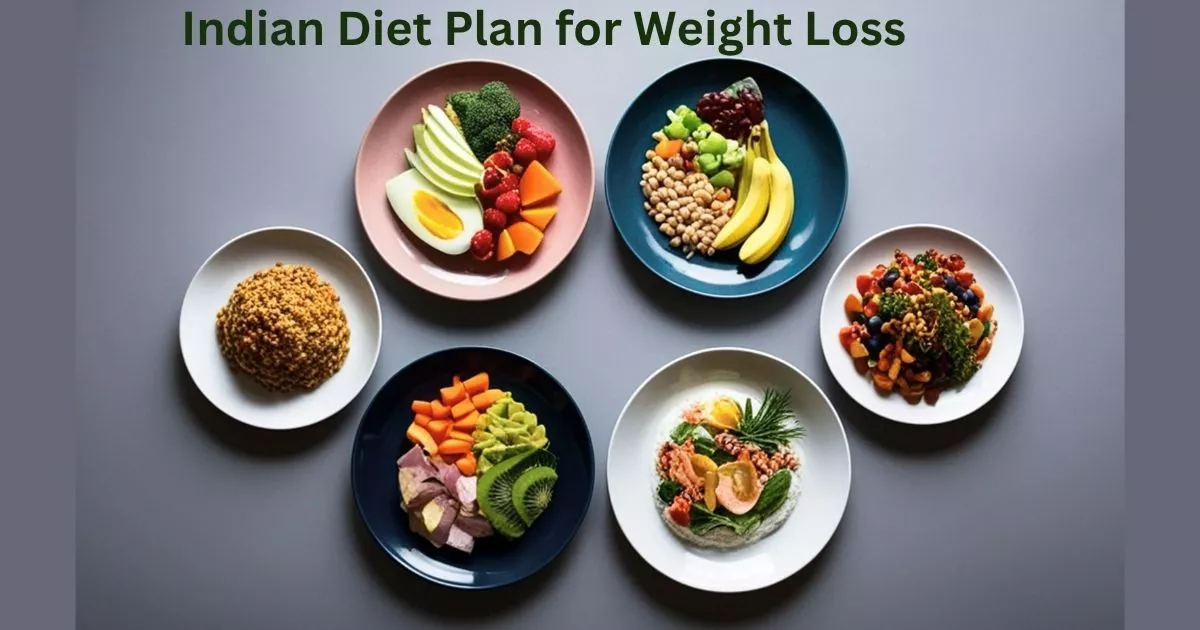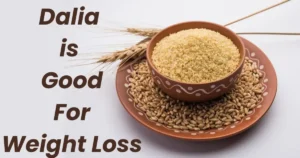Introduction
Indian Diet Plan for Weight Loss doesn’t mean giving up your beloved dal, roti, or masala chai. Rooted in traditional Indian ingredients, this 7-day plan harnesses nutrient-rich foods and metabolism-boosting spices like turmeric and cumin to support safe, sustainable fat loss.
Backed by insights from the Indian Council of Medical Research (ICMR) and top nutritionists, it’s designed to lose 0.5–1 kg per week—without sacrificing flavour or affordability.
Whether you’re a busy professional or a homemaker, the plan prioritises vegetarian meals (with optional non-veg swaps), home-cooked simplicity, and zero dependence on expensive gym memberships.
Read More: Indian Superfoods For Weight Loss
Why This Indian Diet Plan Works for Weight Loss
Indian cuisine, when thoughtfully prepared, is naturally aligned with healthy eating. From fibre-rich millets and protein-packed lentils to antioxidant-loaded vegetables and healing spices, it offers a powerful foundation for weight management.
According to research, a calorie-controlled Indian diet can help reduce body fat by 5–10% within just three months.
Here’s why this plan delivers results:
- Calorie Deficit: Target 1,200–1,500 calories per day, adjusting for your Basal Metabolic Rate (BMR) to ensure safe fat loss.
- Macronutrient Balance: Structure your meals with 50% complex carbs (such as whole grains), 30% lean protein, and 20% healthy fats.
- Hydration & Herbal Support: Drink 3–4 litres of water daily. Enhance detoxification with jeera (cumin) water or antioxidant-rich green tea.
This approach blends science with tradition, making weight loss both achievable and culturally resonant.
7-Day Indian Diet Plan Chart
Here’s an Indian Diet Plan for Weight Loss weekly plan. Each day totals around 1,300 calories. Swap items based on availability, but stick to portions.
| Day | Breakfast (300 cal) | Lunch (400 cal) | Snacks (200 cal) | Dinner (400 cal) |
| Monday | Oats upma with veggies + black tea | Dal tadka (1 bowl) + brown rice (1/2 cup) + salad | Roasted chana (handful) + buttermilk | Vegetable stir-fry + 2 rotis + curd or yougurt |
| Tuesday | Poha with peanuts/black chana + green tea | Paneer bhurji + quinoa (1/2 cup) + cucumber raita | Apple + herbal tea | Moong dal soup + mixed veg sabzi + 1 roti |
| Wednesday | Sprout Idli (2) with sambar + coconut chutney | Chickpea salad + millet roti (2) | Yoghurt/curd with chia seeds | Grilled fish (or tofu) + spinach saag + brown rice |
| Thursday | Besan cheela + mint chutney | Rajma (1 bowl) + jeera rice (1/2 cup) + onion salad | Sprouts chaat | Bottle gourd curry + 2 rotis + lassi |
| Friday | Sattu drink – 2 tbsp sattu with water, lemon, and black salt (great for fullness). | Vegetable pulao (low oil) + curd | Nuts mix (4 almonds, 2 walnuts— pieces) | Lentil soup + stir-fried beans + quinoa |
| Saturday | Dalia porridge with nuts | Egg curry (or soya) + 2 rotis + tomato salad | Masala chai + roasted makhana | Palak paneer + brown rice + salad |
| Sunday | Multigrain paratha (1) + curd/ yoghurt | Mixed dal + veggies + 1 roti | Fresh fruit salad | Clear vegetable soup + grilled veggies + millet khichdi |
Tips for Success
- Cook smart: Limit oil to 1–2 teaspoons per meal. Choose heart-healthy options like mustard, ricebran oil or cold-pressed coconut oil.
- Spice it up: Use ginger, garlic, chilli, and other Indian spices to add flavour without extra calories.
- Track your journey: Track progress and allow customisation for Indian meals and ingredients.
Nutritional Breakdown & Benefits
This Indian diet plan for weight loss delivers a well-rounded nutritional profile:
- Protein: From dals, paneer, and eggs—crucial for muscle repair, satiety, and metabolic health.
- Fibre: Whole grains and vegetables support digestion, regulate blood sugar, and curb cravings.
- Vitamins & Minerals: Fruits and herbs help address common deficiencies like Vitamin D and iron.
Studies have found that similar diet plans significantly improved insulin sensitivity in overweight adults.
Common Mistakes to Avoid
- Skipping meals: Often leads to overeating later in the day.
- Over-relying on rice: Switch to millets, quinoa, or brown rice for a lower glycemic impact.
- Ignoring portions: Use measuring cups or a food scale until you’re confident with serving sizes.
Precautions
While following the Indian Diet Plan for Weight Loss, prioritising safety and balance is key. Extreme calorie restriction or cutting out entire food groups—especially carbohydrates—can slow your metabolism and lead to nutrient deficiencies. Instead, focus on well-rounded meals that include quality protein, dietary fibre, and healthy fats to support energy, satiety, and metabolic health.
Medical Guidance: If you have chronic conditions like diabetes, thyroid issues, or take regular medications, consult your doctor before starting any new diet.
Smart Tracking: Monitor your energy levels, hydration, and portion sizes. Use simple tools like measuring cups or food tracking apps to stay consistent.
Avoid Quick Fixes: Avoid reliance on “quick fixes” like detox teas or meal replacements, or crash diets that promise rapid results but compromise long-term health.
Sustainable Habits: Combine your diet with regular physical activity, restorative sleep, and mindful eating to build a foundation for lasting wellness.
Conclusion
The Indian Diet Plan for Weight Loss proves that lasting transformation doesn’t require extreme restrictions—it thrives on balance. With mindful eating, nourishing home-cooked meals, and consistent daily movement, you can achieve sustainable weight loss while still enjoying the flavours of Indian cuisine.
Avoid skipping meals, crash diets, or eliminating entire food groups. If you have medical conditions like diabetes, thyroid issues, or others, always consult your doctor before starting any new diet plan.
FAQ’s {Frequently Asked Questions}
Q1. Which is the best Indian food for weight loss?
- Vegetables: green leafy vegetables, carrots, cucumbers, tomatoes, pumpkin, brinjal (eggplant), etc.
- Fruits: apple, banana, orange, papaya, pineapple, grapes, pear, etc.
- Cereals & Millets: rice, wheat, jowar, bajra, ragi, maize, etc.
- Pulses, Eggs & Flesh foods: lentils, beans, fish, eggs, and meat.
- Nuts & Seeds: almonds, peanuts, sunflower seeds, etc.
- Fats & Oils: ghee, oil, butter.
- Milk / Curd
Q2. What if I’m diabetic?
If you are diabetic, eat balanced meals with high fibre and protein, and low-GI carbs. Include vegetables, lentils, eggs, paneer, and whole grains. Avoid sugar, white rice, and maida. Eat small meals every 3–4 hours, drink plenty of water, walk after meals, and sleep 7–8 hours for better sugar control.
Q3. How to handle cravings?
Have healthy snacks like nuts or fruit. Chew fennel seeds, brew cinnamon tea or drink warm lemon water added with a teaspoon of honey
Q4. Which breakfast is best for weight loss?
- Moong dal chilla with vegetables
- Oats porridge with nuts
- Sprouts idlis with sambar
- Buttermilk with chia seeds + vegetable daliya
- Vegetable poha with sprouts or black chana
Q5. Can I eat rice and still lose weight?
Yes, you can eat rice and still lose weight—it’s all about portion and variety. Opt for nutrient-dense options like brown rice, red rice, or hand-pounded rice, and keep servings between ½ to 1 cup per meal. Pair your rice with fibre-rich vegetables and protein sources such as dal, paneer, or grilled fish. This combination slows glucose spikes, keeps you full longer, and supports steady weight loss.
Q6. Which Indian drink is best for weight loss?
The best Indian drinks for weight loss are natural, low-calorie, and metabolism-boosting. Top options include:
- Jeera water – improves digestion and burns fat.
- Lemon water – detoxifies and reduces cravings.
- Green tea – boosts metabolism.
- Buttermilk – low in calories, good for gut health.
- Amla juice – supports fat metabolism.
References
Dietary Guidelines for Indians-2024
https://www.nin.res.in/dietaryguidelines/pdfjs/locale/DGI07052024P.pdf
Dietary guidelines across different countries & comparisons to dietary guidelines for Indians




